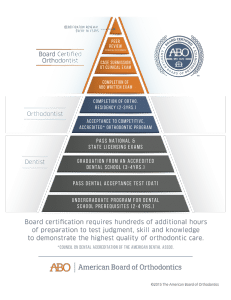Are all orthodontists Board Certified?
No, not all orthodontists are Board Certified. While all orthodontists must be licensed to practice, only about one in three orthodontists have pursued and achieved Board Certification through the American Board of Orthodontics (ABO). This certification signifies a significant achievement beyond the required two to three years of advanced education to become a specialist in orthodontics. Board Certification involves:
- Demonstrating actual accomplishments in patient care through detailed case reports covering a wide range of orthodontic issues.
- A voluntary process that not all orthodontists choose to undertake.
How many certifying boards are recognized by the American Dental Association in the specialty of orthodontics?
There is only one certifying board recognized by the American Dental Association (ADA) in the specialty of orthodontics: the American Board of Orthodontics (ABO). Founded in 1929, the ABO is the oldest specialty board in dentistry. It promotes excellence in orthodontic care through certification, education, and professional collaboration, sponsored by the American Association of Orthodontists (AAO).
Why would an orthodontist choose to complete this voluntary certification process?
Completing the ABO certification process demonstrates an orthodontist’s dedication to excellence in orthodontics to both their profession and the public. It signifies their commitment to maintaining the highest standards of patient care, staying updated with the latest advances in orthodontics, and delivering these advancements to their patients. Many orthodontists view Board Certification as a mark of their commitment to the specialty and a pinnacle of personal achievement.
What steps are required to complete the ABO certification process?

Since its establishment in 1929, the American Board of Orthodontics (ABO) has continuously adapted its certification process to meet the evolving demands of the specialty. Today, the process includes:
- Written Examination: A comprehensive test consisting of 240 questions covering all areas of orthodontic knowledge.
- Clinical Examination: Orthodontists present detailed case reports from their practice or residency, demonstrating excellence in patient care. These cases undergo evaluation by a panel of examiners.
- Oral Examination: Candidates are tested on a wide variety of academic and clinical topics during an oral examination.
- Board Certification: Upon successful completion of these examinations, the orthodontist achieves Board Certification for a time-limited period.
Board Certification must be renewed every 10 years, requiring orthodontists to demonstrate continued excellence in patient care.
For further information about The American Board of Orthodontics and Board Certification, click here.




